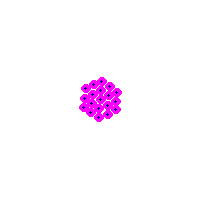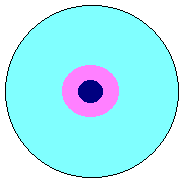
MUHAMMED A. ASADI

I)Embryological Data in
the Koran:
1). "He [i.e God] created
you in the wombs of your mothers in three fold darkness" (Koran
39:6).
The three fold darkness may refer to: i)Anterior
abdominal wall; ii)The uterine wall & iii) Amnio Chronic membrane [Prof
Keith L. Moore- University of Toronto].
2). "Then We [plural of majesty for God] placed him [i.e man/woman] as
a drop [Nutfa in Arabic] in a safe lodging. Then We made the drop [Nutfa] into a
leech like structure [Alaca in Arabic]. Then out of the leech like structure, a
chewed lump [Mudghah in Arabic]. Then out of the chewed lump bones, and We
clothed the bones in flesh. Then we developed out of it another creature.
therefore, blessed be Allah [God], the best of those that create" (Koran 23:
13-14)
ANALYSIS OF KORAN 23:14
i)
"We placed him as a drop in a safe lodging"
The drop
[Zygote] divides to form a blastocyst which is implanted in a safe lodging
[Uterus].
ii) "Then We made the drop into a leech
like structure (Alaca)"
The human embryo [days 7-24] looks and
behaves like a leech. Just as a leech derives blood from the host, the embryo
derives blood from the pregnant endometrium [or decidua]. The embryo of 23-24
days in its appearance, remarkably resembles a leech. As there were no
microscopes available 1400 years back such a statement in the Koran is
fascinating indeed. [Adapted from Keith L. Moore]

Embryo below (Day 24); Leech on top.
iii) "Then out of the leech like structure, we
made a chewed lump [Mudghah in Arabic]"
In Arabic Mudghah
signifies chewed lump or chewed flesh. This is stated in contrast to intact
flesh which is signified by the word Laham [in Arabic].
Towards the end
of the 4th week, the human embryo looks like a chewed lump of flesh. The chewed
appearance results from somites which resemble teeth marks. [Keith L.
Moore]
iv) "Then out of the chewed lump, bones, and
then We clothed the bones in flesh"
This is in accord with
embryological development. First bones form as cartilage models and then muscles
[flesh] develops around them from the somatic mesoderm. [Keith L.
Moore]
v) "Then We develop out of it another
creature"
After the formation of bones and muscles, by the end of
the 8th week, the embryo has distinctive human characteristics and is called a
fetus [refer "another creature"].
3)
"O
mankind! if you are in doubt concerning the resurrection then Lo!, We
have
created you from dust, then from a drop [Nutfa], then from a leech like
structure [Alaca], then from a chewed lump of flesh [Mudghah], partly formed and
partly unformed..."
(Koran 22:5).
The statement "partly formed and partly unformed," may indicate that the
embryo is composed of both differentiated and undifferentiated tissue. [Keith L.
Moore]
When cartilage bones are differentiated, the embryonic connective
tissue [mesenchyme] around them is undifferentiated.
4)
"And He [Allah or God] it is who created Mankind of water" (Koran
25:54).
The Ovum cell from which the human being is
created has as its main functioning portion the cytoplasm which is between
70%-85%water.
5)
"And He [Allah or God] created
the two pairs male and female from an ejaculated
drop" (Koran 53:45,46)

The male sperm is the "ejaculated drop". Females do
not possess ejaculated semen.
The male sperm carrying [maybe] the Y-
chromosome determines sex. Therefore the ejaculated drop determines sex.
There were no microscopes etc to have knowledge of this 1400 years back, the
time of the Koranic revelation.
6) "Surely, We
created man from a mixed (Amshaj in Arabic) drop.." (Koran
76:2)
The Zygote (drop) forms by the union of a mixtures
of the sperm and the ovum.
7) "...And He (God)
gave you hearing and sight and feeling and understanding.." (Koran
32:9).
The above verse has as its context the creation of
mankind. The special senses of hearing, seeing and feeling develop in the
exact same order as mentioned in the above verse. The primordia of the internal
ears appears before the beginning of the eyes, and the brain [the site of
feeling and understanding] differentiates last.
II) Other
data:
8) "Surely those who
disbelieve our signs, We shall burn them at a fire. As often as their skins
are wholly burned, we shall give them in exchange other skins so that they may
keep tasting the punishment [i.e keep feeling the pain of burning]." (Koran
4:56)
Full thickness burns destroy nerve endings so that
further burning does not cause pain. The pin prick test is used to verify full
thickness loss. The Koran informed us about this over 1400 years back when
people knew nothing about full thickness and partial thickness burns and their
anaesthetic effect.
9) "..And you will see
mankind on that day [i.e the day of judgement] as drunken [intoxicated], yet
they will not be drunken [intoxicated].." (Koran
22:2)
Effects similar to intoxication can be produced in
our bodies even though no intoxicant has been consumed [just as indicated by the
above verse of the Koran]. Modern physiology has found this in the case of at
least one pathological state, Mania [which involves feelings of intense euphoria
and frenzied behavior].
10) "We have charged
man(kind) that he/she be kind to his/her parents...; his bearing and his
weaning are thirty months. Then when he is fully developed and reaches FORTY
YEARS.." (Koran 46:15)
Psychological tests show that the
overall quantity of stored knowledge in a person's mind increases during the
first 39 years of his life, reaching a peak at this time (Guyton 207). The Koran
said 40 years much before such psychological tests were conducted.
While
commenting on the above verses of the Koran, please consider the fact that the
Koran was revealed at a time period and place where people had little, if any
scientific knowledge and lacked the equipment to provide such accurate
descriptions contained in the above verses. As no alternative explanation is
found, the "revealed" nature of the above verses is made clear. The Koran claims
to be a revelation from God.
References to the Koran eg 22:5 refer to
Koran chapter (sura) 22, verse or sentence 5.
WORKS CITED
1. Asadi, Muhammed A. Koran: A Scientific Analysis. IPU, Lahore
1992.
2. Guyton, Arthur C. Physiology of the Human Body. 6th edition.
Holt Saunders International Editions.
3. Moore, Keith L. Before We are
Born: Basic Embryology & Birth Defects. 2nd edition. W. B. Saunders Co,
Philadelphia 1983.
4. Moore, K. L. A Scientists Interpretation of
references to Embryology in Al- Qur'an. 1986.
"READ! IN THE NAME OF YOUR LORD
WHO CREATED. CREATED MAN FROM A LEECH LIKE [STRUCTURE]." (KORAN
96:1-20)
Please visit Muhammed Asadi's website
at
http://www.rationalreality.com/
atmosphere
biomedical fingerprint
isostacy
life
quasars seas
space universe
big
bang
Terkini
Artikel
Perpustakaan
Bacaan E-Mail
Hiasan
Kalimat Pilihan
Keratan
Akhbar
Soalan Lazim
Sudut Pelajar English Articles
![]() Tulis kepada Pengurus
Laman
Tulis kepada Pengurus
Laman